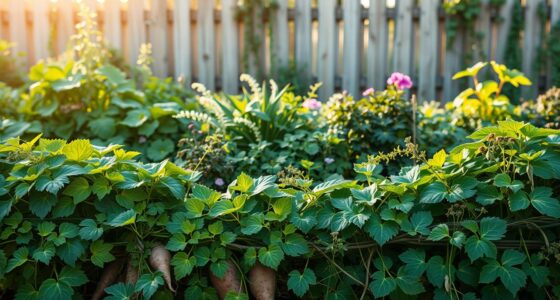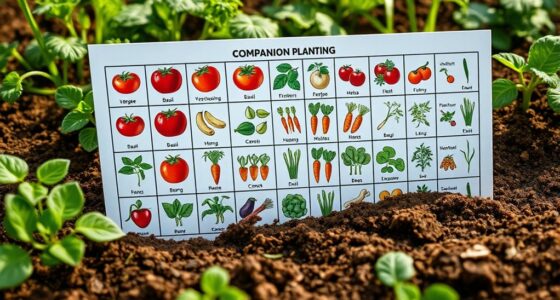For the best results, plant beets alongside herbs like basil, oregano, and thyme, which help repel pests and boost flavor. You can also grow garlic and onions nearby for natural pest control. Leafy greens such as lettuce and spinach thrive in the shade, extending your harvest. Beans and peas enrich the soil with nitrogen, while nasturtiums and dill attract beneficial insects that keep pests in check. Keep exploring to discover even more ways to improve your garden success.
Key Takeaways
- Aromatic herbs like basil, oregano, and thyme repel pests and enhance beet flavor.
- Oregano and dill attract pollinators and beneficial insects, improving beet pollination and pest control.
- Beans and peas fix nitrogen, enriching soil health for healthy beet growth.
- Marigolds and nasturtiums act as trap crops and release pest-repelling compounds.
- Companion planting with fragrant herbs creates a pest-resistant environment and extends harvests.
Lettuce and Leafy Greens
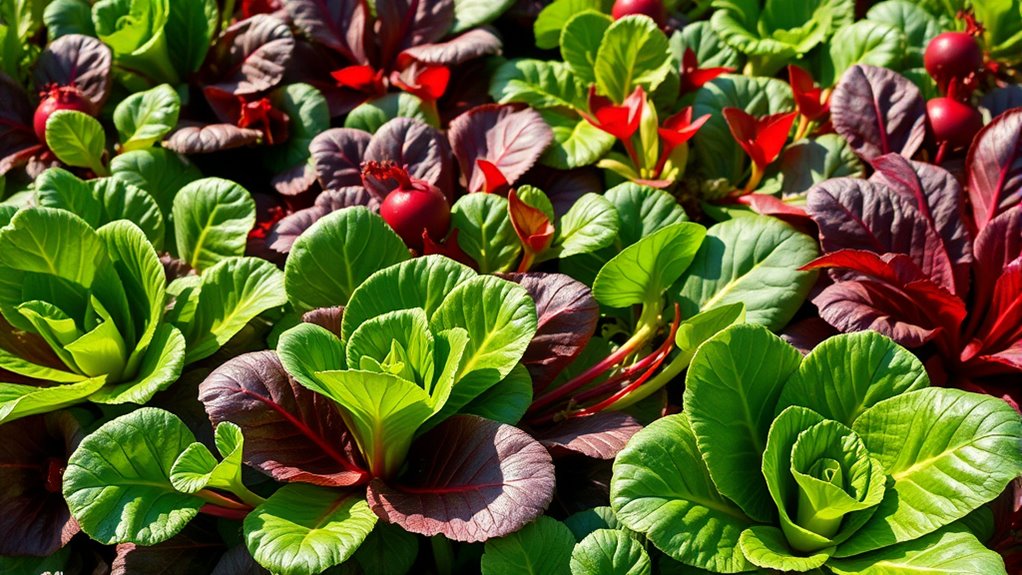
Planting lettuce and leafy greens alongside beets benefits both crops. Lettuce and leafy greens grow quickly, providing ground cover that helps suppress weeds and retain soil moisture, which benefits the slower-growing beets. Their shallow roots won’t compete with beets for nutrients, allowing both to thrive together. Additionally, the cooler temperatures preferred by lettuce and greens can help shade the soil, keeping it cooler and reducing stress on beets during warmer days. As they grow, the greens can also improve soil health by adding organic matter when they are harvested or if they are cut back. Incorporating companion planting strategies can further enhance crop health and yield. This mutual relationship promotes healthier plants and maximizes garden space, making your vegetable patch more productive and efficient. Using self watering plant pots can help maintain consistent soil moisture for both crops, especially during dry spells.
Onions and Garlic
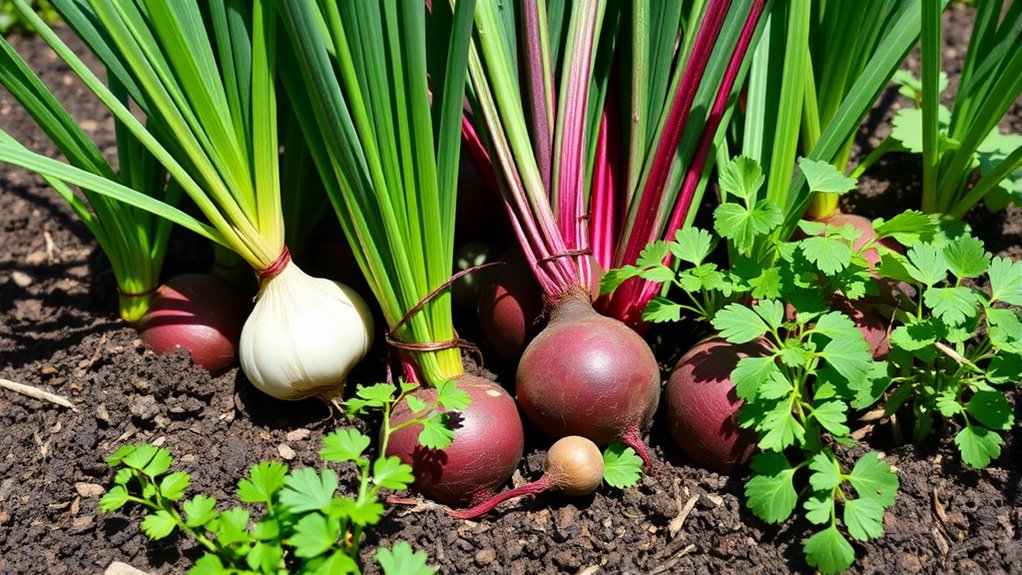
Pairing onions and garlic with beets creates a mutually beneficial planting combination. Onions and garlic act as natural pest repellents, deterring aphids, beetles, and other unwanted insects that target beets. Their strong scents confuse pests and reduce the chances of infestations, protecting your beet crop. Additionally, onions and garlic can improve soil health by suppressing certain soil-borne diseases that affect beets. These companions don’t compete heavily for nutrients, so they can grow well together. Plant onions and garlic around the edges of your beet bed or intersperse them among the beets to maximize space and pest control. Their presence also adds a layered defense, helping ensure your beets stay healthy and vigorous throughout the growing season. Incorporating companion planting strategies can further enhance your garden’s productivity and resilience.
Cabbage Family Members
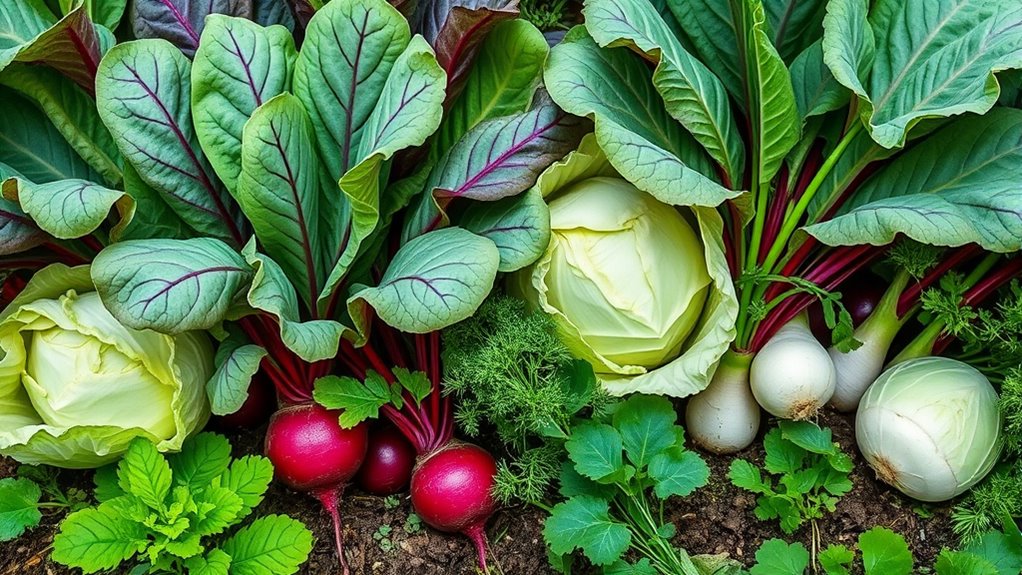
Members of the cabbage family, such as kale, broccoli, and Brussels sprouts, make excellent companions for beets because they can help repel pests and improve garden health. These plants release compounds that deter common pests like aphids and cabbage worms, reducing damage to your beets. Additionally, their presence promotes healthy soil by encouraging beneficial microorganisms. To optimize your garden, consider pairing these vegetables thoughtfully. Incorporating plant diversity can further boost the resilience of your garden ecosystem. Proper crop rotation practices with these plants can prevent soil-borne diseases and maintain soil fertility over time. Here’s a simple guide:
| Cabbage Family Member | Benefits for Beets | Planting Tips |
|---|---|---|
| Kale | Pest deterrent | Space 12 inches apart |
| Broccoli | Disease resistance | Rotate yearly |
| Brussels Sprouts | Soil improvement | Plant early in season |
| Cabbage | Pest control | Keep soil moist |
| Cauliflower | Companion growth | Use supportive stakes |
Herbs Like Dill and Coriander

Herbs like dill and coriander can substantially benefit your beets by attracting helpful insects and enhancing soil health. Dill attracts pollinators and predatory insects that keep pests at bay, creating a balanced garden ecosystem. Coriander, or cilantro, draws beneficial insects like hoverflies and parasitic wasps, which help control common beet pests. These herbs also improve soil quality by supporting diverse microbial activity, which benefits your beets’ growth. Incorporating companion plants like these can enhance soil health and promote a thriving garden environment. Additionally, planting these herbs can align with supermarket hours today to ensure you pick up fresh herbs at optimal times, making your gardening and planting routines more efficient. Research shows that companion planting can lead to healthier, more productive crops. By attracting and supporting beneficial insects, these herbs contribute to a more balanced ecosystem in your garden. Proper plant placement is crucial to maximize their pest-repelling effects and attract the right pollinators. Consider these advantages:
- Attract pollinators that aid in beet flowering and seed production
- Lure predatory insects that naturally control beet pests
- Enrich soil biodiversity, promoting healthy root development
Plant dill and coriander nearby to maximize these benefits, creating a thriving, pest-resistant beet patch.
Radishes and Other Quick-Growing Roots
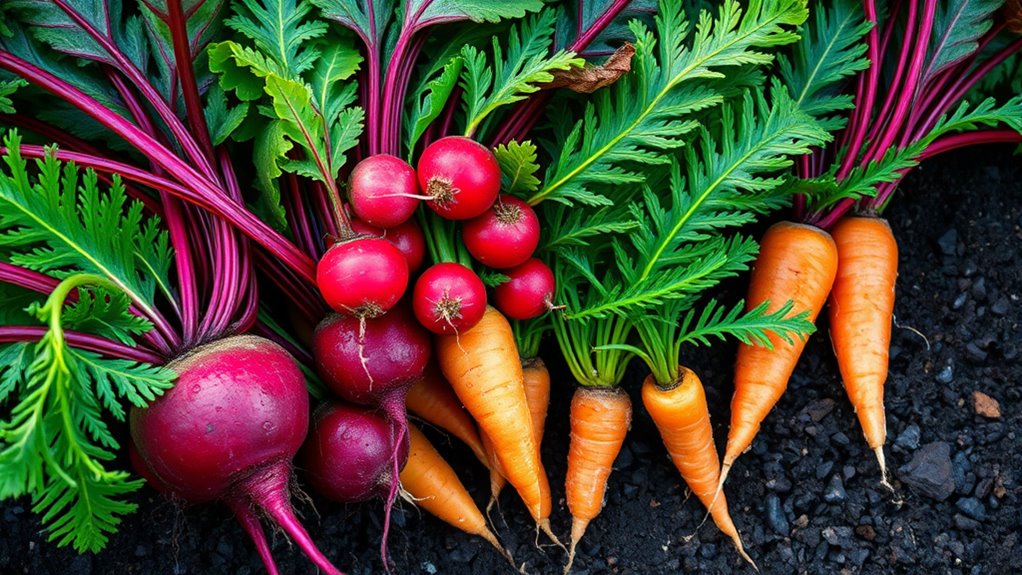
Planting radishes and other quick-growing roots alongside beets can accelerate your garden’s productivity by providing rapid harvests and improving soil health. Radishes grow fast, often ready in just a few weeks, allowing you to maximize space and get multiple harvests from the same bed. As they develop, their roots loosen compacted soil, making it easier for beets to grow deeper and healthier. Additionally, radishes can act as a trap crop for pests like flea beetles, protecting your beets from damage. Both radishes and beets have similar soil and sunlight needs, making them compatible companions. Incorporating interior design principles such as layering textures and colors can create a more inviting garden space that enhances your gardening experience. Incorporating vibrational energy practices such as expressing gratitude and visualization can further enhance your gardening success. Understanding the cost factors of gardening tools and supplies can help you plan your garden investments more effectively. Moreover, selecting appropriate plant varieties can further optimize your garden’s overall yield and resilience. Incorporating soil health techniques like crop rotation and organic amendments can also improve long-term productivity and sustainability.
Marigolds for Pest Control
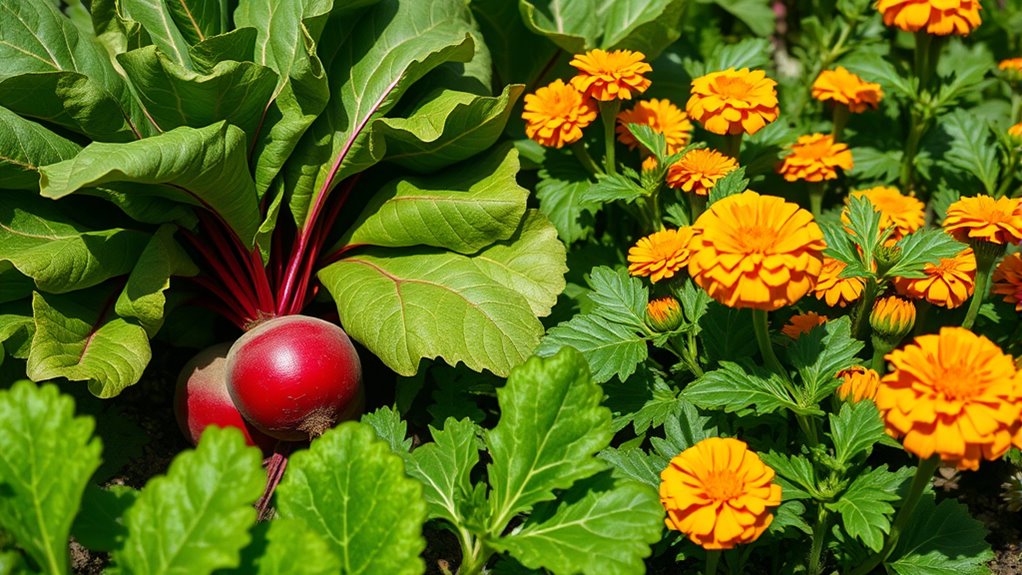
Plant marigolds near your beets to help keep pests at bay naturally. They release compounds that act as a pesticide, reducing the need for chemicals. Plus, marigolds attract beneficial insects that can protect your crop even further. Incorporating companion planting techniques such as this can significantly improve your garden’s health and yield. Additionally, planting near water sources like watering areas can encourage beneficial insect activity, enhancing pest control efforts. Using integrated pest management strategies with diverse plantings can further bolster your garden’s defenses. Properly managing your garden environment, including plant placement, can optimize the benefits of companion plants like marigolds. Implementing appropriate plant choices based on your local climate can also maximize pest deterrence and plant growth.
Marigolds as Natural Pesticides
Have you noticed how marigolds can naturally deter pests from your beet crops? They release compounds that repel harmful insects, making them an excellent natural pesticide. By planting marigolds nearby, you reduce the need for chemical pest control and protect your beets effectively. Additionally, marigolds can attract beneficial insects that prey on pests, boosting your garden’s natural defenses. Some pests that marigolds repel include: – Nematodes, which attack roots – Aphids, common on leafy greens – Mosquitoes and other flying insects. Marigolds are easy to grow and add vibrant color to your garden, providing pest control without harmful chemicals. Their scent acts as a natural barrier, encouraging beneficial insects like ladybugs and predatory wasps that help keep pest populations in check. Incorporating marigolds is a simple, eco-friendly way to safeguard your beets, especially since they can also improve soil health through their compounds released. Moreover, integrating marigolds into your garden can lead to a more balanced ecosystem, reducing the need for chemical pesticides and supporting sustainable gardening practices.
Companion Benefits for Beets
Marigolds offer significant companion benefits for your beets by naturally controlling pests that threaten your crop. Their strong scent repels harmful insects like nematodes, aphids, and beetles, reducing the need for chemical pesticides. Planting marigolds nearby creates a barrier that confuses pests and discourages them from settling on your beets. Additionally, marigolds attract beneficial insects such as predatory beetles and parasitic wasps, which help keep pest populations in check. This symbiotic relationship promotes healthier, more vigorous beets without extra effort. By incorporating marigolds into your garden, you not only enhance pest control but also improve soil health and attract pollinators. This practice aligns with sustainable gardening practices principles of sustainable and natural gardening solutions to create a thriving garden ecosystem. Overall, marigolds are a simple, effective way to protect your beets naturally while boosting your garden’s vitality.
Nasturtiums to Deter Pests
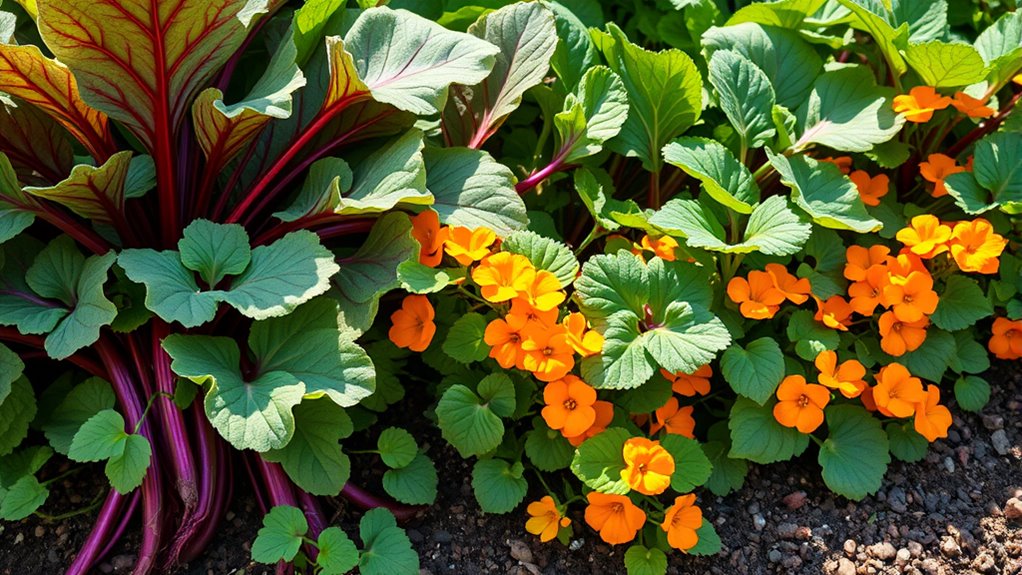
Nasturtiums are a great natural pest deterrent for your beets because they repel harmful insects. They also attract beneficial bugs that help control pests naturally. Planting nasturtiums nearby can boost your garden’s overall health and reduce the need for chemical treatments.
Pest-Repelling Properties
Nasturtiums are known for their ability to repel common beet pests, making them a valuable companion plant in your garden. They emit strong scents that confuse pests like aphids, beetles, and whiteflies, discouraging them from settling on your beets. By planting nasturtiums nearby, you create a natural barrier that reduces pest populations without chemicals. These vibrant flowers also attract pests’ natural enemies, helping to maintain balance in your garden ecosystem. Additionally, nasturtiums can act as trap crops, luring pests away from your beets entirely. To maximize their pest-repelling properties, consider planting them close to beet roots and regularly inspecting for pests. Incorporating nasturtiums into your garden not only enhances beauty but also provides a practical pest control strategy.
Attracts Beneficial Insects
By planting nasturtiums nearby, you can attract beneficial insects that naturally control pests. These vibrant flowers draw in predatory insects like ladybugs, hoverflies, and parasitic wasps, which target common beetle and aphid pests. When these beneficial insects frequent your garden, they help keep pest populations in check without the need for chemicals. Nasturtiums act as a magnet for these helpful bugs, providing them with nectar and pollen. As a result, your beets stay healthier and less stressed from pest attacks. Plus, nasturtiums are easy to grow and add a splash of color to your garden. Incorporating nasturtiums near your beets creates a natural pest management system that promotes a balanced, thriving garden ecosystem.
Spinach and Other Shade-Tolerant Crops

Because beets prefer full sun but can tolerate some shade, planting shade-tolerant crops like spinach nearby can extend your harvest and maximize garden space. Spinach grows quickly and can be harvested multiple times, making it an excellent companion. It also helps shade the soil, conserving moisture and reducing weed growth. Other shade-tolerant crops to contemplate include lettuce, Swiss chard, and arugula, which thrive in less direct sunlight and can be harvested early or throughout the season. Plant these crops around your beets to optimize space and promote healthy growth. Keep in mind that these plants benefit from similar soil conditions and watering routines, creating a harmonious and productive garden environment. Incorporate these shade-tolerant crops for a more efficient and diverse garden.
Beans and Peas for Nitrogen Fixation
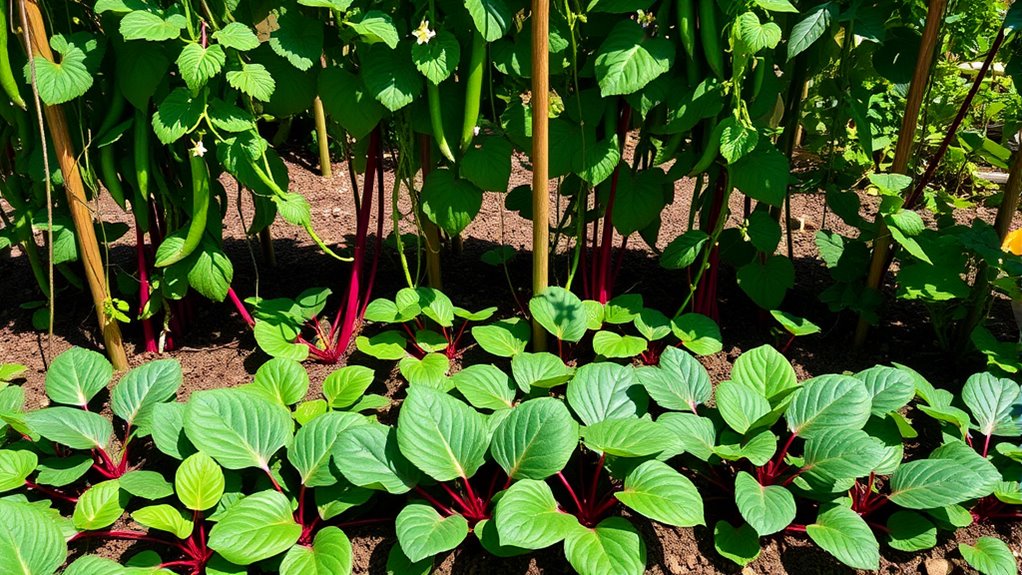
Planting beans and peas nearby helps boost your soil’s nitrogen levels naturally. This not only enhances soil fertility but also promotes healthier beets. By choosing these legumes as companions, you support stronger, more vigorous plants overall.
Enhance Soil Fertility
Including beans and peas in your beet planting area can considerably boost soil fertility through their natural ability to fix nitrogen. These legumes establish a symbiotic relationship with bacteria in their roots, converting atmospheric nitrogen into a form plants can absorb. This process enriches the soil, reducing your need for synthetic fertilizers and promoting healthy beet growth. To maximize benefits, consider planting beans and peas nearby or in rotation with your beets. This partnership not only improves nutrient levels but also enhances soil structure and microbial activity. Incorporate these plants into your garden to create a more sustainable and productive environment. Remember, healthy soil leads to healthier beets, so don’t overlook the power of legumes for soil enhancement.
- Improves nitrogen content naturally
- Supports overall soil health
- Reduces fertilizer dependency
Improve Plant Health
Beans and peas actively improve plant health by fixing atmospheric nitrogen into the soil, which benefits nearby crops like beets. This natural process enriches the soil with nitrogen, a essential nutrient that supports healthy growth and robust foliage. As you plant these legumes alongside your beets, you’ll notice stronger, more vigorous plants with better resistance to pests and diseases. The nitrogen they provide reduces the need for synthetic fertilizers, making your garden more sustainable. Plus, beans and peas grow quickly and densely, providing ground cover that suppresses weeds and conserves moisture. Their presence creates a healthier environment for your beets, leading to larger, tastier roots. Incorporating beans and peas into your planting strategy truly enhances overall plant health and garden vitality.
Basil and Other Aromatic Herbs

Basil and other aromatic herbs can be excellent companions for beets, as they help improve growth and flavor while deterring pests. These herbs release natural compounds that repel beetles and aphids, reducing the need for chemical pest control. Additionally, their presence can enhance the overall flavor of your beets, making them more aromatic and delicious. Planting basil nearby may also attract beneficial insects like pollinators and predatory insects that keep pests in check. To maximize benefits, consider the following:
Plant aromatic herbs like basil to boost beet flavor and deter pests naturally.
- Basil: Repels pests and boosts beet flavor
- Oregano: Attracts pollinators and beneficial insects
- Thyme: Acts as a natural pest deterrent and improves soil health
Incorporating these herbs creates a fragrant, pest-resistant environment that promotes healthy beet growth.
Frequently Asked Questions
How Do Companion Plants Influence Beet Flavor and Quality?
Companion plants can substantially influence the flavor and quality of your beets. When you plant certain companions, they can deter pests, improve soil health, and promote better nutrient uptake. For example, planting onions or garlic nearby can repel beet pests, leading to healthier beets with better flavor. Additionally, some plants shade the soil, conserving moisture and reducing stress, which helps you harvest sweeter, more tender beets.
Can Certain Plants Improve Beet Storage Life?
Certain plants can indeed help improve your beets’ storage life. By planting onions or garlic nearby, you can reduce mold and rot, thanks to their natural antifungal properties. Keeping beets in a cool, dark, and well-ventilated space also prolongs freshness. Regularly removing excess foliage prevents decay, and storing beets in perforated bags or crates helps maintain ideal humidity, ensuring they stay fresh longer.
Are There Specific Companion Plants That Repel Beet Pests?
Ever wonder if certain plants can keep pests away from your beets? You might be surprised to learn that planting onions or garlic nearby can help deter beet pests like aphids and flea beetles. These strong-smelling companions create a scent barrier that confuses or repels unwanted insects. So, next time you’re planning your garden, consider these natural pest fighters—they could be just what your beets need to thrive pest-free.
How Do Companion Plants Affect Beet Growth Stages?
Companion plants influence beet growth at each stage by providing benefits like pest control, improved soil health, and shade. You can plant herbs like dill or cilantro early to attract beneficial insects, or grow leafy greens nearby to provide shade and retain soil moisture. These plants also help suppress weeds and enhance nutrient uptake, ensuring your beets develop strong roots and healthy foliage throughout their growth cycle.
Which Companion Plants Attract Beneficial Insects for Beets?
You might have heard that certain plants attract beneficial insects, but is it true? Yes, it is! Flowers like dill, fennel, and yarrow draw in pollinators and predatory insects that help keep pests away from your beets. By planting these nearby, you create a natural pest control system. This way, you protect your crop while encouraging a healthy, balanced garden ecosystem.
Conclusion
Think of your garden as a symphony, where each plant plays a essential role. By choosing the right companions for your beets, you create a harmonious environment that boosts growth and keeps pests at bay. When you plant lettuce, herbs, and beans alongside your beets, you’re conducting a thriving orchestra of nature. With these allies, your garden will flourish like a well-tuned melody, rewarding you with vibrant, healthy harvests.



